
On the night of Aug 16/17, 2010, I observed the cataclysmic variable star V592 Her in outburst. My measurements show that it had an average magnitude of about V=16.0, with very little variation except for a sharp drop of 0.35 mag in about 22 minutes at the end of my run.
The setup was:
Notes from the night
This is a chart of the field based on an image from Aug 08 UT. The field of view is about 9 arcminutes on a side.

I wasn't able to measure star "D" on this night; the graphs below use a different star in its place.
I measured the instrumental magnitude of each star with aperture photometry, using a radius of 5 pixels = 5.3 arcseconds and sky defined by an annulus around each star. Following the procedures outlined by Kent Honeycutt's article on inhomogeneous ensemble photometry, I used all stars available in each image to define a reference frame, and measured each star against this frame.
One output of the ensemble solution is the value of the zero-point of each frame relative to the others. In the graph below, I plot this zero-point as a function of time. Note the gradually increasing value, which might be due to increasing airmass as the target set -- if so, the extinction coefficient for these unfiltered measurements would be about 0.3 mag/airmass, which seems reasonable.
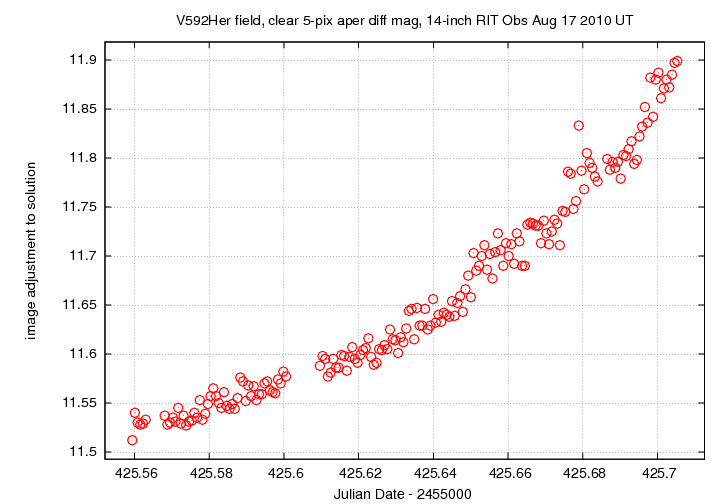
Below is a graph of the scatter in differential magnitude versus magnitude in the ensemble solution.
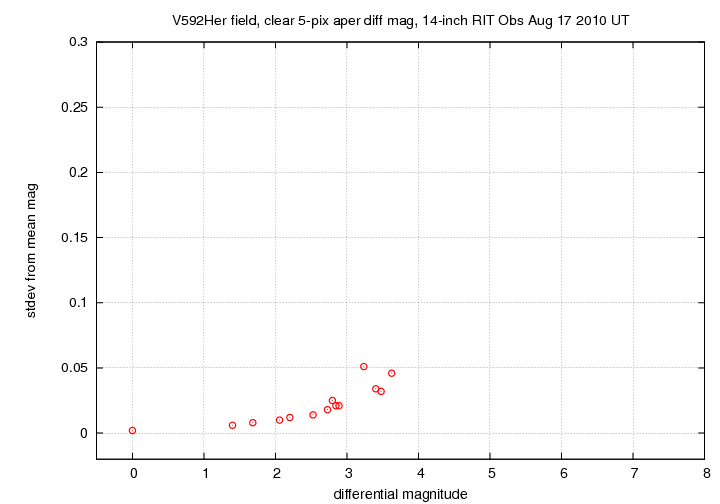
The floor of this diagram is hard to judge: there's one very bright star, "A", which dominates the solution. Its scatter is only 0.002 mag, but that is probably misleadingly small. The next-brightest star has a scatter of 0.006 mag.
The star with slightly elevated scatter near differential magnitude 3.2 is the target, V592 Her. No other stars in the field show significant variation.
Light curves for selected stars (V592 Her and stars A - F) in the field are shown below. The target is shown by light green crosses.
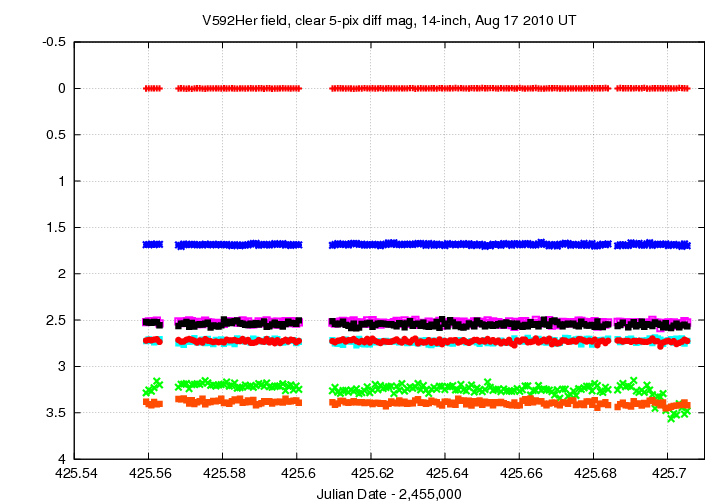
Below is a closeup of the light curve of V592 Her and a couple of comparison stars (which I have shifted vertically for convenience). Note the almost constant brightness for most of the run, followed by a very sharp drop at the end.
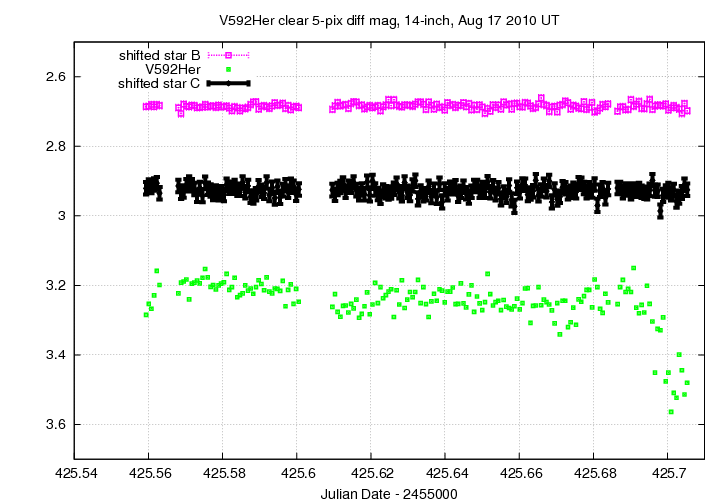
I've made a table of the measurements themselves, with three different flavors of time. The differential magnitudes from the ensemble solution have been shifted so that star "A" in my chart, USNOB1.0 1112-0258663, has value 12.784, which is its V-band magnitude according to Henden's calibration.
Here's the start of the table.
# Measurements of V592Her made at RIT Obs, Aug 17, 2010 UT, # in fair conditions, # by Michael Richmond, using 14-inch Celestron and SBIG ST-9E CCD. # Exposures 60 seconds long, no filter. # Tabulated times are midexposure (FITS header time - half exposure length) # and accurate only to +/- 1 second (??). # 'mag' is a differential magnitude based on ensemble photometry # using a circular aperture of radius 5.3 arcseconds. # which has been shifted so USNOB1.0 1112-0258663 has mag=12.784 # which is its V-band magnitude according to Henden via AAVSO. # # UT_day JD HJD mag uncert Aug17.05940 2455425.55940 2455425.55996 16.069 0.031 Aug17.06012 2455425.56012 2455425.56068 16.037 0.030 Aug17.06083 2455425.56083 2455425.56139 16.051 0.030
I made another set of tests of off-axis guiding on this night, using a video camera behind a 90mm refractor which is mounted piggyback on the 14-inch telescope. The new feature tonight was a focal reducer, which gives the video camera a wider field of view. Here are two pictures of the Moon taken last night: on the left, the bare camera; on the right, the camera with focal reducer.
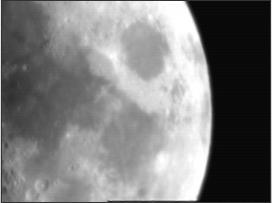
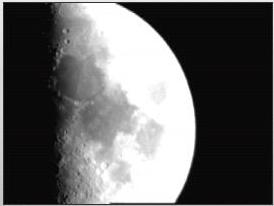
Very rough measurements indicate that the focal reducer decreases the plate scale by a factor of 2; in other words, the pixels cover twice as many arcseconds in each direction, the field of view increases by a factor of 2 in each direction, and the overall area inside the field increases by a factor of 4. The plate scale might be something like 3.5 arcsec per pixel in this mode, but I need to make better tests to be sure.
When I pointed to V592 Her and used PHD guiding with a 2-second integration period, I was able to see 3 or 4 stars in the video camera's images. The stars might have been around magnitude V=11, but, again, I need to run better tests. I was able to guide on one very easily. Below is a graph showing the apparent motion of stars in the main camera's images over the course of the run.
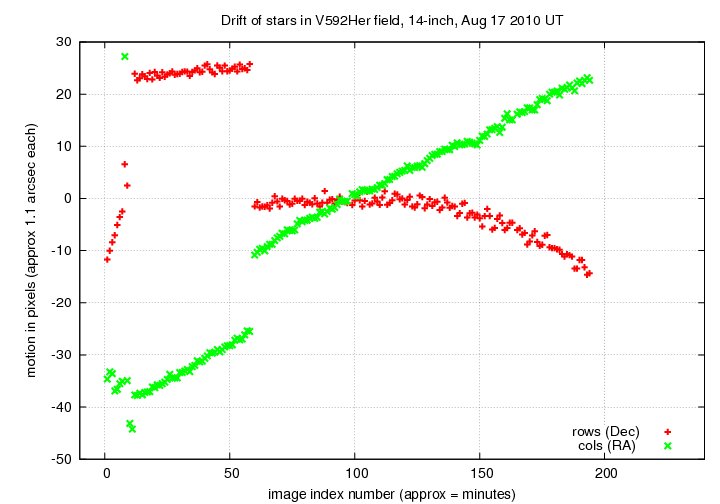
There are three sections in this graph. Note that the plate scale of the main camera is close to 1 arcsec per pixel, and the images had 60 second exposure times, so they come at roughly 1 minute intervals.
My guess is that the gradual drift is due to flexure between the small guidescope and the main telescope.
The scatter in position from image to image, around the main trendlines, ranges from 0.33 pixels (on small consecutive runs of images) to 0.54 pixels (over large periods of time). That's close to the scatter seen on Aug 26, 2010, when I was guiding without the focal reducer. This is good: it means that the focal reducer provides roughly the same precision for guiding, but with a field of view much larger.
Last modified 8/17/2010 by MWR.